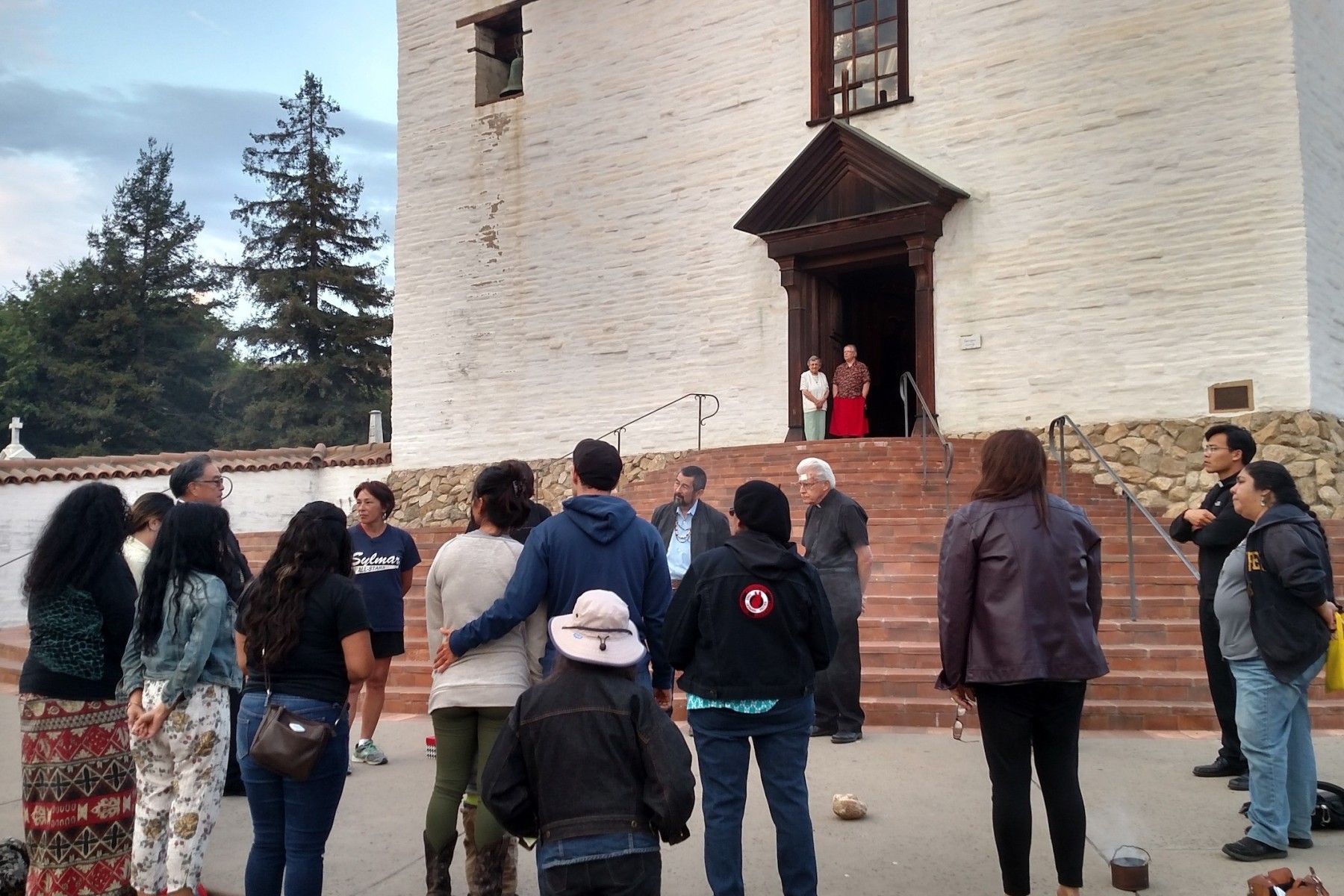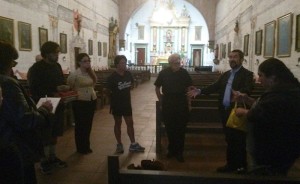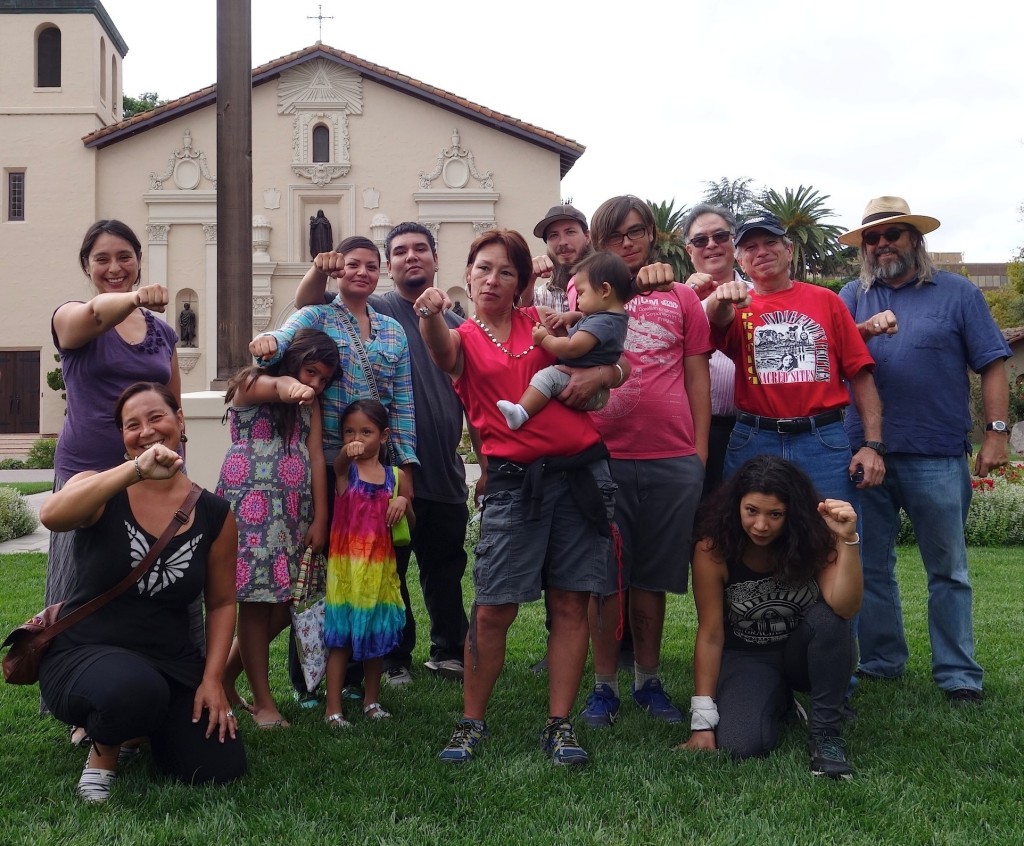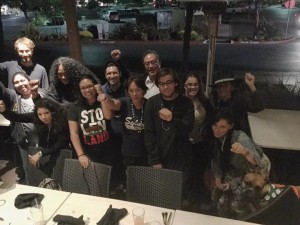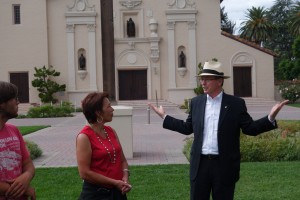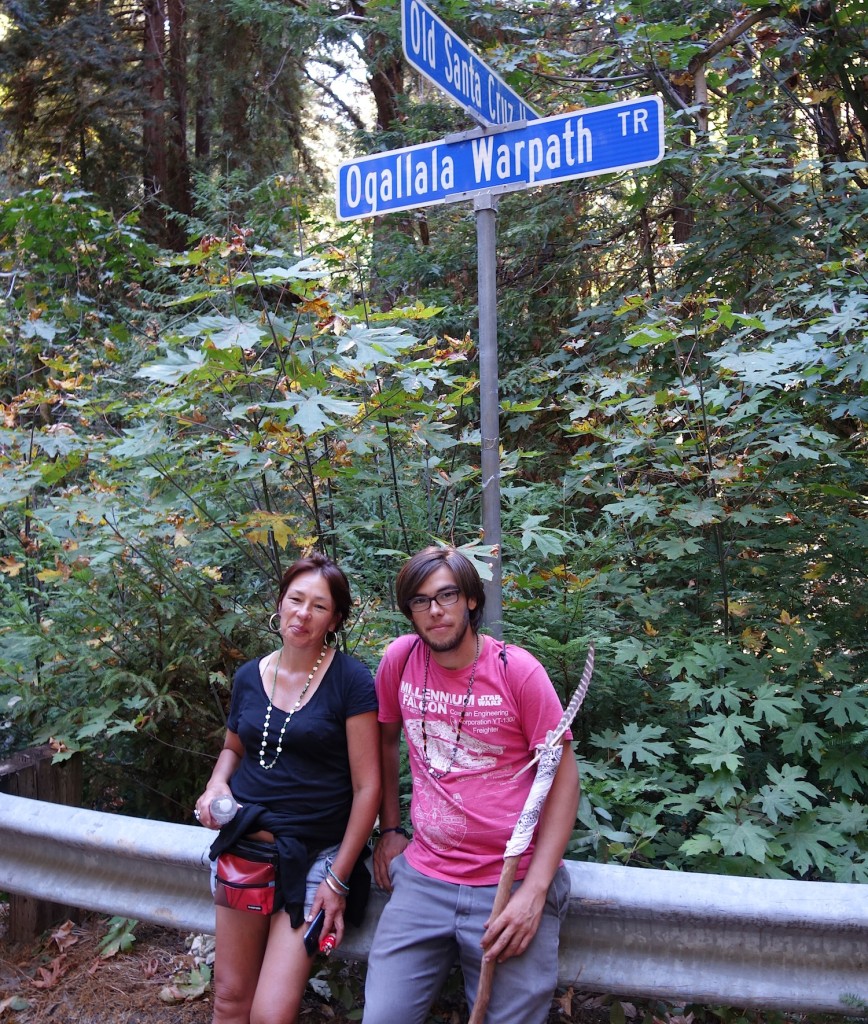Posted on September 19, 2015
San Jose & Santa Clara: Encounters with Priests and Presidents
On Monday evening, we reached Mission San Jose after crossing through the wetlands of the South Bay. On the steps of the Mission chapel, we were greeted by a strong group of supporters and indigenous people, including Chochenyo Ohlone matriarch Corrina Gould, whose ancestors were enslaved at Mission San Jose. We also encountered Andrew Galvan, an Ohlone descendant who is a paid emissary of the Catholic Church and an outspoken supporter of Serra’s sainthood, and soon found out he’d hatched a plan of his own for the evening.
Galvan had arranged for two priests, a deacon, and two nuns to be present, and to have the Chapel doors open, so that we might be beckoned inside. After smudging and holding a circle of introductions and story sharing on the steps outside, we cautiously stepped into the chapel for what became a surreal collision of opposing interests.
The controversy around Serra’s sainthood, Galvan explained, has created a prime opportunity to advance his long-held evangelical vision: to bring California Indians back in to the Catholic Church. He described ongoing efforts at making the Church a more inviting environment to California’s Native peoples, many of whom have long abandoned the Catholic faith.
His advances were swiftly rebuffed by Corrina Gould. “We need more voices included in the dialogue, not just yours, in order to hear our ancestors… When I think about this Mission, I think about all the things that were taken from us, the devastation that was brought upon our communities, and how our ancestors were made to suffer. Nothing you say can ever change that reality. Being welcomed in to this Mission that’s already ours in not going to change that. The Pope already apologized to the Indigenous people across the world for what the Catholic Church has done. But an apology without action means nothing.”
After Corrina Gould and Caroline had spoken, a priest who was present asked, “What would you like to see happen?" Corrina and Caroline glanced at each other. “We want our land back.” Caroline said. “We want what is rightfully ours.”
Corrina agreed. Looking towards the priest, she added, “And I ask that you stand up, stronger and taller than Junipero Serra was. If he was a man of his time, then he was only a man. If he was a Saint, then he would have stopped the destruction and devastation. And so, I say that if you’re going to Washington DC to watch the falsehood take place, that you stand up, and you say that it’s wrong.”
“I was actually raised Catholic,” Corrina explained. “Then I found out later on about all the horrific stuff that happened during the Missionization of our people. And how my mother ended up in the orphanage right here, at Mission San Jose, and how devastating her life was, because of what she suffered here. Here, where my ancestors have suffered before. And so, there’s no way that I can stand on the back of my ancestors and not say loudly that Junipero Serra was a monster, and that what he did can’t be changed. You can’t go back in time and make that different.”
The decrepit old building reverberated with feeling as Fuifuilupe Niumeitolu, of Tongan descent, shared a powerful Hawaiian chant. Other Walk supporters in the room also spoke their minds and hearts. “I don’t know any other Saint who was ever a person that enslaved a people, who disrespected them so much— that’s the truth,” peace activist and lawyer Steven Nakano exclaimed. “He was a slave owner like the plantation owners in the South, like the pharos in Egypt. To declare him a saint seems contrary to any kind of moral purpose.”
Part two: Footsteps to Santa Clara
After a hearty dinner in the company of many wonderful people who sent us off with their heartfelt blessings and gifts, we got started the next morning with an all-day walk to Tamyen Ohlone territory in Santa Clara, joined by five women from Santa Cruz.
Caroline and Kagen are feeling inspired by how this Walk is connecting them with other indigenous people. “I am realizing that while this walk is first and foremost about honoring our ancestors, it is also about intertribal relations and building solidarity between all California Indians,” Caroline said.
Mission Santa Clara is located on the grounds of Santa Clara University, a Catholic school. According to historian Robert Jackson, between 1777 and 1840, the missionaries recorded 5,691 baptisms of Indian converts, 2,446 births, and 7,076 burials. That translates to a death rate of 86.96% (basically 90%). Despite this shocking number of burials, we could not find any grave markers or any plaques about the indigenous people who perished here.
After hearing the stories and prayers of the 16 people who had gathered with us for the ancestors, a twist of fate came our way. The president of Santa Clara University, Michael Engh, happened to come strolling by. Someone in our circle recognized him and asked him to join us—and he did.
Kagen and Caroline greeted him, and conveyed the purpose of the walk and of our gathering. Kagen continued, “You know, I look around your campus, and around the Mission, there’s some nice pieces of art, a couple of statues. There is only the narrative that the Church has presented, and that is a very positive image of well being and charity. Well, it’s just not true. For me, personally, I would like to see something right out in the forefront, recognizing whose land this church, this building, this school, is on—and recognizing how the people here suffered, and how they died.”
Michael Engh’s response was sympathetic. “Yes, the question that’s come up because of the canonization, is how do we recognize the people who lived here, who worked and died here. And that is in front of the whole faculty right now. As of last night we were discussing that. And I agree with you, there’s a lot that we need to do.” Yet, he also said that in the hierarchy of the Church, he is only a “little guy,” implying that his perspective is not shared by other officials.
We told him that if this process of reformulating the University’s presentation of the Mission’s history is to have integrity, it needs to involve the input of a range of Ohlone and California Indian people— not just one individual, or one particular Ohlone group. This especially makes sense when you consider that though it’s Tamyen Ohlone territory, other California tribes were also imprisoned at Mission Santa Clara, including significant numbers of Sierra Miwok and Northern Valley Yokuts peoples.
“The longer the journey gets, the harder it is. It’s hard to keep your integrity and try to stay humble, when emotionally, you’re just drained from hearing the stories of what happened to the ancestors and seeing all the ways they are disrespected.” Caroline told the group. “Yet, I believe we are the generation that’s going to make the changes our ancestors prepared us for, with all their stories and what they went through. We are just getting stronger, as we walk.”

